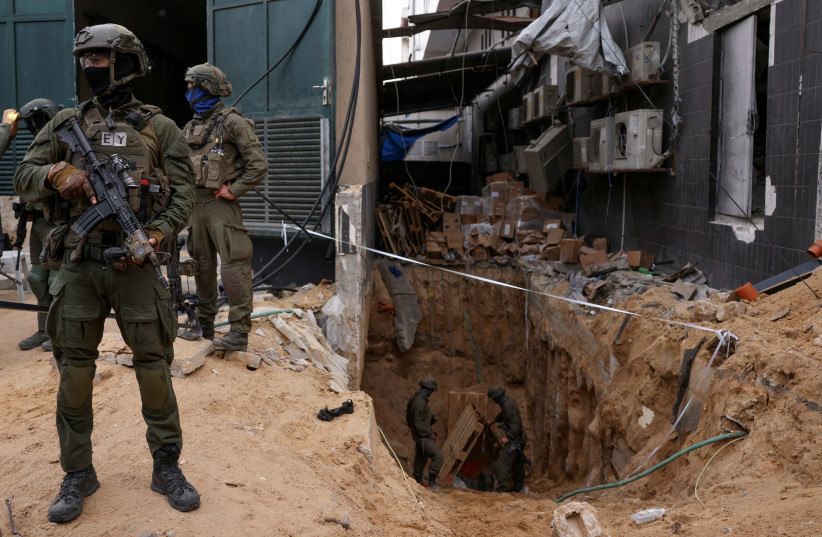‘They were hiding in every corner’: IDF special forces commander talks to ‘Post’
Egoz special forces platoon commander Lt. N. spoke with The Jerusalem Post on Sunday about the varying challenges of fighting Hamas in some of the deadliest battles of northern Gaza, places such as the Shati and Jabalya refugee camps, as well as in southern Gaza, especially Khan Yunis.
Throughout all of the battles his unit participated in, including on October 7, they killed about 200 Hamas terrorists, N. said. He also lost four of his commanders on October 7 and another during battles in Gaza, and some of his soldiers were wounded.
N., who has served in Egoz for five years, described his platoon’s experiences in large-scale battles, including with his commander, at the rank of major. His unit entered northern Gaza a couple of weeks into the invasion, he said. They had intensive battles there for about five days, in addition to mopping up smaller terrorist group operations afterward, he added.
Shati was difficult from a professional military perspective, N. said, because the IDF could not manage to get the full range of forces – including tanks and artillery assistance – to enter the very narrow alleyways.
No room for vehicles
There was also no room for engineering and obstacle-clearing vehicles, which could both protect the soldiers and help dispose of encroachments and booby traps. Instead, his forces often had to slowly creep through alleyways in essentially single-file lines. This left them much more exposed to potential ambushes.

The terrain was challenging because “only one person was able to move at a time through the northern alleyways,” N. said. “We know how to fight an enemy, but we still could not use all of our qualitative advantages” because of the narrow area to maneuver and the difficulty in seeing the enemy.
“There were lots of hiding places and structures,” he said. “They were hiding in every little corner.”
But unlike October 7, “the fighting itself was what we are used to, without having to worry about Israeli civilians being in the way,” N. said. “They have a clear defense line; we have a clear offense line. We were at home in terms of a standard tactical situation.”
“We went house to house,” he said. “We initiated and did not wait for them to attack.”
N.’s unit later fought in northern Gaza, with battles in Jabalya, particularly at the Indonesian Hospital. Then in December, N’s special forces joined in the invasion of southern Gaza, including about six weeks of fighting in Bani Suheila and Khan Yunis.
In that invasion, Egoz joined hundreds of regular infantry forces along with the other special forces, tanks, artillery, the Oketz dog unit, the Yahalom anti-tunnel unit, and sharpshooters. N. said there was a larger volume of enemy Hamas forces in the South, compared with what he saw in Shati, but he also said it was easier to fight them because the area was broader.
The houses were larger and more like villas, not like the very small houses in the Shati refugee camp, leaving more space in between them to maneuver and fewer spots for Hamas to hide, N. said.
Nevertheless, “tunnels were a larger problem than in northern Gaza,” he said. “Every spot had a tunnel shaft, [and they were] everywhere.”
N. said he felt resistance in Khan Yunis was fading, and that the IDF could potentially achieve general operational control in the near future.
All of this came after N. was already hardened from the deadly and painful experience of fighting to repel Hamas’s invasion on October 7.
On that Saturday, he had eight soldiers under his command along with other officers.
He woke up at 7 a.m. to calls and messages about many kibbutzim in the South getting invaded, including videos.
N. said he could tell the situation was “very complex, but I did not yet fully understand the magnitude of the event,” something that took weeks.
Along the way, N. and his unit saw large numbers of bodies of both Israeli civilians and Hamas terrorists.
His forces were initially called on to assist at Re’im, but while driving there, they were given updated orders to redirect to Kissufim. When they arrived, they heard heavy gunfire. Many regular infantry soldiers, who were taken by surprise or were outnumbered, were seeking safety in a school. Some were already dead or wounded.
N. started to map out the area and to establish a physical defense line that his forces could take up.
“This was a different kind of war,” he said. “Usually, we come to attack with all of our weaponry and means. Here, we couldn’t just let loose with gunfire everywhere because there were civilians. This meant we had to get right up close to them.”
He said his unit had saved civilians and killed terrorists. It lost four soldiers.
N. also described tactics for taking prisoners. In one case that could be a paradigm for other cases, he said, they had an intense gunfight with four Hamas fighters. Three were killed, and the fourth one was wounded.
After approaching the fourth from a distance to make sure he was wounded, neutralized, and unarmed, they took him into custody.
N. sat with the Post during a three-day break from fighting, but he and his Egoz commandos were expected to return to Gaza shortly.





Comments are closed.